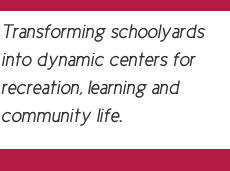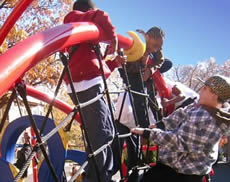News
| Contact Information Alison Risso, KaBOOM!, 202-464-6076 |
| Boston Schoolyard Initiative Recognized for Excellence in Getting Kids Active and Playful |
| Boston, MA (October 1, 2009) - In a new report, Play Matters, national non-profit KaBOOM! has searched the country for local initiatives that have increased the quantity of available play spaces and opportunities, improved the quality of kids playtime, and increased children’s safe access to them. KaBOOM! is the national non-profit bringing play back into the lives of children. The Play Matters report was commissioned as part of the organizations Playful City USA campaign, which seeks to honor communities across the country who have made a commitment to improving the lives of their children through play. Boston Schoolyards was one of 12 programs the organization singled out as an example of great ways communities can help get their kids active and healthy. To make the cut, each of the 12 initiatives had to show proven results and represent a significant commitment to increasing play and physical activity. In addition, the program or initiative also needed to be something other communities could do themselves to increase the amount of play in their own children’s lives. The Boston Schoolyard Initiative is a public-private partnership, initially inspired by the green movement, that has constructed new schoolyards across the city. With the leadership of Mayor Thomas Menino, the Boston Schoolyard Initiative has transformed the outdoor physical space of more than 70 Boston schoolyards into colorful and engaging outdoor classrooms and places to play. The project enjoys ongoing public support and is a sustainable model that relies on public-private funding and a comprehensive maintenance program to provide accessible and high-quality play spaces. More than $4 million in private funds and close to $16 million in public funds have been invested in designing and constructing comprehensive schoolyards across Boston. Mayor Menino has been the leading political champion for this effort, safeguarding resources during an economic downturn and positioning this project as part of his education reform agenda. Boston has constructed or reconstructed schoolyards and outdoor classrooms at 71 of the district’s 130 schools, including almost 90% of the city’s elementary schools. The play spaces cover 125 acres and serve almost 30,000 students. Boston Schoolyard Initiative is on track to have 85 schoolyard projects completed by 2010. Boston Schoolyard Initiative has renovated schoolyards in each of the city’s 15 neighborhoods. The 71 new play and educational spaces are open to the general public after school hours, serving over 90,000 children under age 14 living in these Boston neighborhoods. “The Boston Schoolyard Initiative’s unique partnership with the City of Boston and Boston Public Schools has been transforming Boston’s schoolyards into dynamic centers for recreation, learning and community life since 1995,” said Myrna Johnson, executive director of the Boston Schoolyard Funders Collaborative. “We’ve been at it for 14 years, but it never gets old watching the spaces we renovate come to life with activity, as children, schools and neighborhoods make them their own. Thanks, KaBOOM! for recognizing our work.” Why the focus on play? A recent Institutes of Medicine report on ways to cut childhood obesity rates recommends that communities should “build and maintain parks and playgrounds that are safe and attractive for playing, and in close proximity to residential areas” in order to increase children’s activity levels. The IOM went on to single out some of the best practices highlighted in the Play Matters report by encouraging cities to “collaborate with school districts and other organizations to establish joint use of facilities agreements allowing playing fields, playgrounds, and recreation centers to be used by community residents when schools are closed; if necessary, adopt regulatory and legislative policies to address liability issues that might block implementation.” Childhood obesity rates have nearly tripled since 1980, from 6.5% to 16.3%; more than 30% of U.S. children and youth are obese or at risk of becoming obese.* Approximately 175,000 individuals under the age of 20 have type 2 diabetes, and two million young people between the ages of 12 and 19 have pre-diabetes. Many government, scientific, and public health agencies recommend that school-age children and adolescents participate in at least 60 minutes of moderate to vigorous physical activity every day.** Two-thirds of our children fall far short of meeting this standard. By spotlighting the great work of Boston Schoolyards and the other selected programs, KaBOOM! hopes to show other communities different playful ways they can address their growing childhood health and educational issues. Other initiatives honored include: Ankeny, Iowa: Parks and Recreation Department – After failing to pass a bond measure to build a sports complex, the Parks and Recreation Department engaged citizens in the planning process, and they responded in record numbers, which gave the Parks and Recreation Department the political capital develop even more places to play. Baltimore, Maryland: Playworks -- Playworks sends coaches into low-income schools to facilitate play during recess and the rest of the school day. As a result of the program, schools are reporting improved classroom behavior. Boulder, Colorado: The Freiker Program -- Freiker (short for “frequent biker”) uses incentives and technology to increase the number of children regularly bicycling and walking to school. A solar-powered Freikometer counts bike trips, which earn kids points to get prizes and recognition. Cedar Rapids, Iowa: The Switch Program -- Switch What You Do, View, and Chew aims to increase children’s physical activity (“Switch What You Do”), decrease their screen time (“Switch What You View”), and increase their fruit and vegetable consumption (“Switch What You Chew”). Denver, Colorado: Learning Landscapes -- Learning Landscapes is a public-private partnership that designs and builds comprehensive outdoor play spaces at schools across Denver. In addition to engaging the community in the design-and-build process through joint-use agreements, these play spaces were opened up to the community after school hours. Greenbelt, Maryland – In order to keep local Home Owner Associations from removing playgrounds in an effort to avoid maintenance fees, the City of Greenbelt formed public- private partnerships with them and took over a percentage of the upkeep costs. In return, the Home Owner Associations open their play spaces up to all citizens of Greenbelt. New York City – Over the last few years, grassroots advocacy groups and community members have caused an increase in applications for block parties and high profile street closures. In urban areas, street closures are a cost- effective way to provide children with access to safe, open areas for play. San Francisco -- To improve on public transparency and accountability, the Neighborhood Parks Council developed ParkScan, a tool where folks can use the internet to document, report, and track park maintenance issues. Seattle, Washington -- The High Point Housing Project provides a model of a mixed- income and intergenerational planned community that was designed with a focus on healthy living. By engaging residents and collaborating agencies, the authority created a community oriented to walking and full of safe accessible play areas. St. Petersburg, Florida -- St. Petersburg Mayor Rick Baker developed the Play’n’ Close to Home initiative to create a playground within a half mile of every child in the city. Through joint-use agreements with the school district and community organizations, the city has significantly improved opportunities for play. Tucson, Arizona -- A joint-use agreement between the city and its largest school district meant that the city paid for the playground’s safety upgrades and upkeep and the schools open their playgrounds and athletic fields to the public. * “F as in Fat: How Obesity Policies are Failing in America,” Robert Wood Johnson Foundation. ** Building "Generation Play.
|




